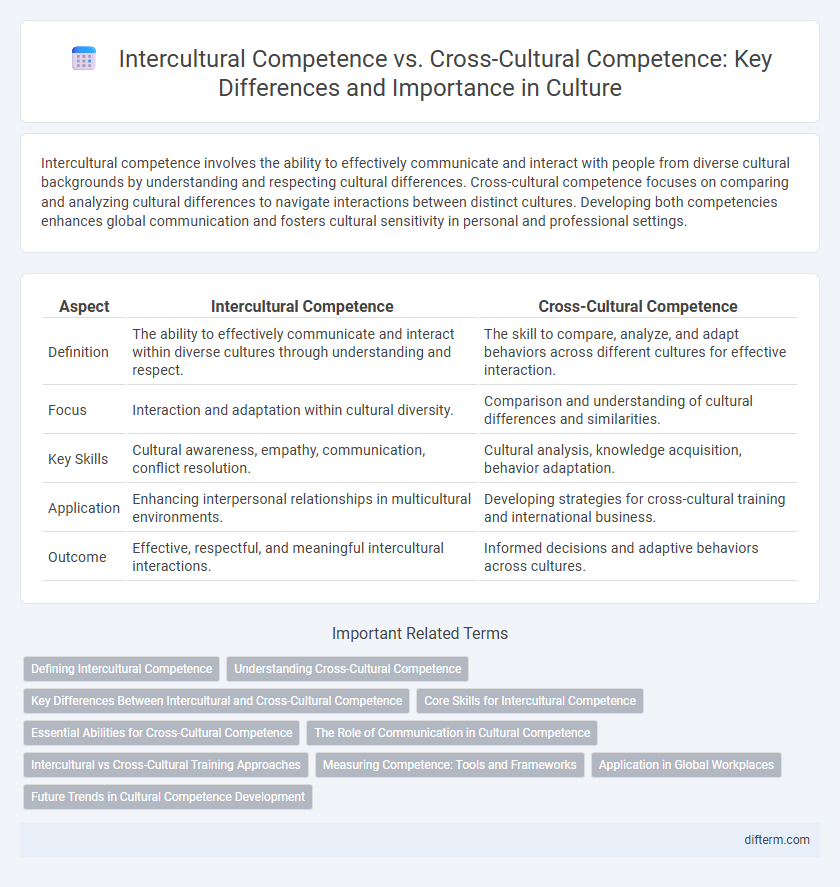Intercultural competence involves the ability to effectively communicate and interact with people from diverse cultural backgrounds by understanding and respecting cultural differences. Cross-cultural competence focuses on comparing and analyzing cultural differences to navigate interactions between distinct cultures. Developing both competencies enhances global communication and fosters cultural sensitivity in personal and professional settings.
Table of Comparison
| Aspect | Intercultural Competence | Cross-Cultural Competence |
|---|---|---|
| Definition | The ability to effectively communicate and interact within diverse cultures through understanding and respect. | The skill to compare, analyze, and adapt behaviors across different cultures for effective interaction. |
| Focus | Interaction and adaptation within cultural diversity. | Comparison and understanding of cultural differences and similarities. |
| Key Skills | Cultural awareness, empathy, communication, conflict resolution. | Cultural analysis, knowledge acquisition, behavior adaptation. |
| Application | Enhancing interpersonal relationships in multicultural environments. | Developing strategies for cross-cultural training and international business. |
| Outcome | Effective, respectful, and meaningful intercultural interactions. | Informed decisions and adaptive behaviors across cultures. |
Defining Intercultural Competence
Intercultural competence refers to the ability to effectively communicate, interact, and collaborate with individuals from diverse cultural backgrounds by understanding and respecting differences in values, beliefs, and behaviors. This competence involves cognitive, affective, and behavioral skills that enable individuals to adapt their communication styles and navigate cultural nuances sensitively. Unlike cross-cultural competence, which often compares cultures externally, intercultural competence emphasizes ongoing, dynamic interactions and mutual learning between cultures.
Understanding Cross-Cultural Competence
Cross-cultural competence involves the ability to effectively communicate and interact with people from different cultural backgrounds by recognizing and respecting diverse cultural norms, values, and practices. Understanding cross-cultural competence requires awareness of cultural differences and the development of skills to navigate these variations in global cooperation, business, and social interactions. Mastering this competence enhances global teamwork, reduces cultural misunderstandings, and fosters inclusive environments.
Key Differences Between Intercultural and Cross-Cultural Competence
Intercultural competence involves the ability to communicate and interact effectively with people from diverse cultural backgrounds by understanding cultural nuances, values, and behaviors. Cross-cultural competence focuses on comparing and analyzing similarities and differences between multiple cultures to facilitate collaboration and minimize misunderstandings. The key difference lies in intercultural competence emphasizing interpersonal skills within specific cultural interactions, while cross-cultural competence centers on broader cultural comparisons and systemic understandings.
Core Skills for Intercultural Competence
Intercultural competence centers on developing core skills such as empathy, adaptability, and effective communication to navigate complex cultural contexts, whereas cross-cultural competence emphasizes comparative knowledge between cultures. Key abilities include active listening, cultural self-awareness, and conflict resolution, essential for fostering mutual understanding in diverse settings. Mastery of these core skills enables individuals and organizations to bridge cultural gaps and enhance collaborative outcomes globally.
Essential Abilities for Cross-Cultural Competence
Essential abilities for cross-cultural competence include effective communication, cultural awareness, and adaptability, enabling individuals to navigate diverse cultural contexts with sensitivity and respect. These skills foster a deeper understanding of cultural norms, values, and behaviors, promoting collaboration and minimizing misunderstandings. Mastery of cross-cultural competence supports successful interactions in globalized environments by bridging cultural gaps and enhancing mutual respect.
The Role of Communication in Cultural Competence
Effective communication is central to both intercultural competence and cross-cultural competence, enabling individuals to navigate language barriers, contextual nuances, and nonverbal cues. Intercultural competence emphasizes dynamic interaction and adaptation in real-time conversations, while cross-cultural competence involves comparative understanding of different cultural norms and communication styles. Mastery of verbal and nonverbal communication strategies fosters empathy, reduces misunderstandings, and enhances collaborative outcomes across diverse cultural settings.
Intercultural vs Cross-Cultural Training Approaches
Intercultural competence training emphasizes developing deep understanding, empathy, and effective communication skills to navigate cultural differences within diverse social contexts. Cross-cultural training approaches focus on comparing distinct cultural norms and behaviors to identify differences and similarities for smoother interactions in multinational environments. Both methods are essential for fostering global collaboration, with intercultural training targeting personal adaptability and cross-cultural training enhancing cognitive awareness.
Measuring Competence: Tools and Frameworks
Measuring intercultural competence involves assessing skills such as empathy, cultural awareness, and adaptability using frameworks like the Intercultural Development Inventory (IDI) and the Cultural Intelligence (CQ) Scale. Cross-cultural competence evaluation often employs tools that compare behaviors and communication styles across distinct cultures, utilizing models such as Hofstede's Cultural Dimensions and the Global Leadership and Organizational Behavior Effectiveness (GLOBE) study. Effective measurement integrates both qualitative and quantitative methods to capture the nuanced understanding and application of cultural knowledge in diverse settings.
Application in Global Workplaces
Intercultural competence emphasizes the ability to effectively communicate and adapt within diverse cultural contexts by understanding cultural nuances and values. Cross-cultural competence involves comparing and contrasting cultural differences to manage and collaborate across multiple cultures in global workplaces. Both skill sets are crucial for enhancing team dynamics, negotiation, and conflict resolution in multinational corporations.
Future Trends in Cultural Competence Development
Future trends in cultural competence development emphasize integrating intercultural competence with cross-cultural competence through advanced digital simulations and AI-driven immersive experiences. These technologies enable personalized learning paths that adapt to diverse cultural norms and communication styles, enhancing real-world application and empathy. Organizations increasingly prioritize continuous, data-informed training that bridges cultural knowledge gaps to foster global collaboration and innovation.
intercultural competence vs cross-cultural competence Infographic

 difterm.com
difterm.com